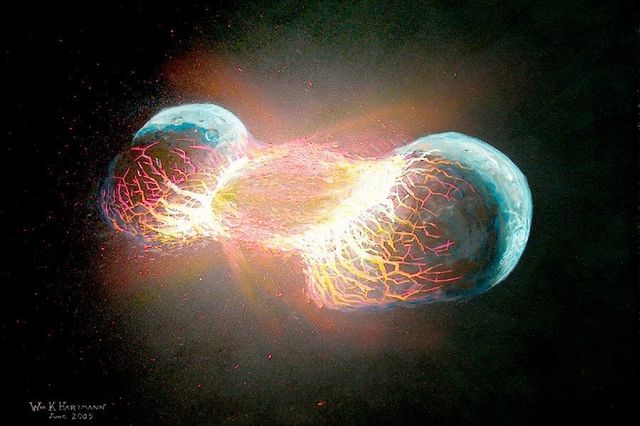
The extremely similar chemical composition of rocks on the Earth and moon helped scientists determine that a head-on collision, not a glancing blow, took place between Earth and Theia. ((c) William Hartmann)
It’s been theorized by a number of scientists that the moon was formed as the result of a collision between an early Earth and a protoplanet known as Theia, named after the mother of the goddess of the moon in Greek mythology, some 4.5 billion years ago (around 100 million years after Earth formed).
But scientists seem to differ on the ferocity of the collision. Some say that Earth grazed Theia at an angle of 45° while others, including those who have just published a new study in the journal Science, say that the collision was more of a violent, head-on crash.
The new study from an international team of scientists, led by geochemists from UCLA, examined rocks taken from the moon by Apollo astronauts and volcanic rocks from the Earth’s mantle.
Using new state of the art methods and technology, including UCLA’s new mass spectrometer, the researchers studied oxygen isotopes in both the moon and earth rocks and found that the chemical signature created from the ratio of the isotopes were the same.
“We don’t see any difference between the Earth’s and the Moon’s oxygen isotopes; they’re indistinguishable,” says the study’s lead author Edward Young, a professor of geochemistry and cosmochemistry at UCLA in a press release.
The new findings are different to those made in 2014 by German scientists who found that the moon had a different ratio of oxygen isotopes than Earth.
Young says that identical oxygen chemical signatures in both Earth and moon rocks supports their theory that Earth and Theia had a violent head-on collision. If the collision between the two was a glancing blow, Young says that most of the Moon would have been mostly made up of Theia.
“Theia was thoroughly mixed into both the Earth and the Moon, and evenly dispersed between them,” Young said. “This explains why we don’t see a different signature of Theia in the Moon versus the Earth.”
Young says that while Theia wasn’t able to survive the violent collision intact, parts of the proto-planet do make up significant portions of Earth and Moon today. He also says that if the collision never happened, Theia would have gone onto become a full-fledged planet that would have been about the same size of Earth. Other scientists differ and say that Theia’s size would have been smaller, perhaps the size of Mars.





















Comments are closed.